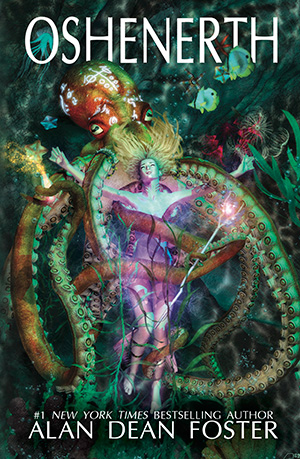Oshenerth: Blue MagicContents of this Issue: Galapagos Sky, Galapagos Islands Itís Not Just the Fishermen Who Are Destroying Reefs What Rats Can Tell Us about Drinking, Diving and DCS The Sun Diver Loses Another Diver Bahamas, French Polynesia, St. Vincent Thereís More to Undercurrent Than This Issue From Shark Baiters to Shark Riders? What Every Liveaboard Needs for Their Aging Clientele Nudibranch and Sea Slug Identification: Indo-Pacific Getting a Post-Dive Call from the U.S. Air Force Travel Agent or the Internet? Part I What Really Happened to the Truk Siren? Editorial Office: Ben Davison Publisher and Editor Undercurrent 3020 Bridgeway, Suite 102 Sausalito, CA 94965 from the February, 2016 issue of Undercurrent
Undercurrent contributor Alan Dean Foster has written 125 books, including Star Wars: The Force Awakens, which recently made The New York Times’ list of best-selling print and eBooks. His latest effort is an epic that takes place entirely underwater. As opposed to a work of science fiction, this book is pure fantasy. The difference? Science fiction explores what’s possible, even if improbable, while fantasy explores the impossible. Foster introduces us to a race of people who reversed evolution and returned to the oceans. An imaginative world this fanciful can hardly be described in conventional terms, so Foster creates his own vocabulary, such as the term “mersons,” humanoids with gills who can communicate with other sea creatures. Freed from the conventions of traditional earth-bound writers, Foster indulges in extravagant wordplay, starting with his title (pronounce it slowly, out loud). The story begins when a merson hunter named Chachel and his best friend, a cuttlefish named Glint, encounter an alien figure drifting on the “mirrorsky,” or ocean surface. Although concerned they may have encountered a demon, they bring the unconscious figure down to their village shaman, a giant octopus named Oxothyr, who performs a little magic to fit her out with merson-like gills and fins. Impressed with her unique perceptions, Oxothyr becomes her mentor and takes her under his tentacles.
It helps that these underwater characters can communicate with each other. At one point, Chachel the hunter encounters a “silvery school of big-eyed trevally,” which “offered insulting remarks.” Foster writes, “Chachel ignored them. One did not waste time quarreling with food.” But then news arrives that a nearby settlement has been attacked by an army of spralakers, a collection of crabs, but not your usual Louis dwellers -- some are as big as tanks. From then on, the book turns into a war novel, as Oxothyr rallies his followers to fight the crusading crustaceans. We never truly learn what motivates the spralakers, although their leader obliquely calls their campaign “the Overturning.” The armed hard-shells seem intent on destroying other communities, rather than occupying them. Parable-huggers can draw their own conclusions. Are the spralakers conducting a secular jihad? A regime-change invasion? Is Irina an interloper or a savior? It’s up to us to work these puzzles out. The book ends with a climactic battle with an inventive array of weapons, but before the matter of battle has even settled, Oxothyr expresses concerns about other looming problems: “I do not feel that I can identify the true nature of the greater menace that threatens us all.” Sounds like a lead-in to a sequel, in the great Star Wars tradition. Purchase Oshenerth through Undercurrent at www.undercurrent.org/UCnow/bookpicks.shtml -- you’ll go to Amazon.com and the commission we earn will go to various projects to save coral reefs. --Larry Clinton, co-author of There’s a Cockroach in My Regulator |

I want to get all the stories! Tell me how I can become an Undercurrent Online Member and get online access to all the articles of Undercurrent as well as thousands of first hand reports on dive operations world-wide
| Home | Online Members Area | My Account |
Login
|
Join
|
| Travel Index |
Dive Resort & Liveaboard Reviews
|
Featured Reports
|
Recent
Issues
|
Back Issues
|
|
Dive Gear
Index
|
Health/Safety Index
|
Environment & Misc.
Index
|
Seasonal Planner
|
Blogs
|
Free Articles
|
Book Picks
|
News
|
|
Special Offers
|
RSS
|
FAQ
|
About Us
|
Contact Us
|
Links
|
3020 Bridgeway, Ste 102, Sausalito, Ca 94965
All rights reserved.

 At first, all goes swimmingly (yes, the puns are contagious), while
the changeling Irina adapts to her new surroundings,
a reef colony called Sandrift. Foster uses his diving experience to
vividly portray his exotic cast of characters,
such as the “manyarm” Glint, who expresses emotions by changing color.
I once thought Pixar did a good job
capturing the personalities of undersea critters in Finding Nemo, but
Foster’s insights blow them out of the water
(sorry, but imitation is the sincerest form of flattery).
At first, all goes swimmingly (yes, the puns are contagious), while
the changeling Irina adapts to her new surroundings,
a reef colony called Sandrift. Foster uses his diving experience to
vividly portray his exotic cast of characters,
such as the “manyarm” Glint, who expresses emotions by changing color.
I once thought Pixar did a good job
capturing the personalities of undersea critters in Finding Nemo, but
Foster’s insights blow them out of the water
(sorry, but imitation is the sincerest form of flattery).